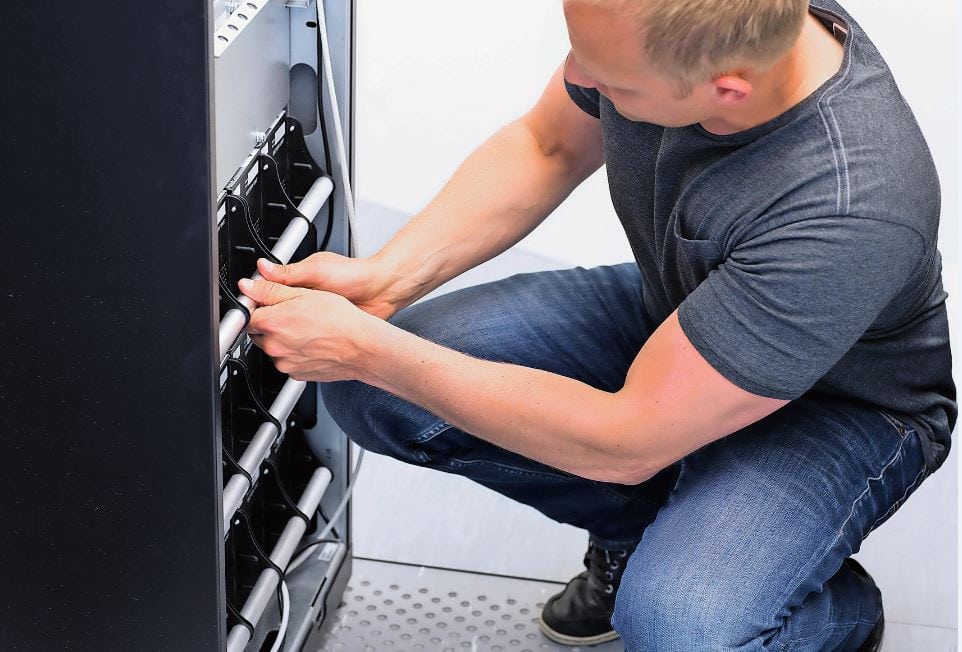Resilience and availability in video technology
In security technology, the topic of availability has always been essential; after all, the relevant protection goals of a security concept should also function in the event of malfunctions and failures, especially of the power supply. In the area of the IT system "video technology", however, this is not the case.

Let us first consider the hardware architecture of such a system: there is always a field level in which the cameras are arranged. The following level is already the final one for small systems, namely the server level, which is consolidated with the functions of image storage, image output and alarm management in said small applications. Larger applications require dedicated hardware levels for the following application-typical functions:
- Storage takes place as close to the camera as possible on special hardware that is optimized for permanent read/write access.
- Video management is a classic server application, alarm management and video
analysis as well (with the latter shifting more and more to the cameras). - The image output is realized by clients.
- And last but not least, of course, the ubiquitous data network that makes communication between all levels possible in the first place.
Different risks
It can be seen that these levels are exposed to the adversities of everyday life to varying degrees. The camera, especially the remote camera, is exposed to the full force of wind and weather, the environment of a client is more manageable, and servers should be located in an absolute IT comfort zone. But how do you protect yourself against power supply problems at these levels?
Cameras availability
Let's start with the cameras: Does the old model still apply here, that short power failures of individual cameras do not have a war-deciding effect, because they are localized and can be handled after reconnection? Probably not, because usually cameras and
whose supporting infrared spotlights are supplied via PoE (Power over Ethernet). Thus, the power supply usually comes from a PoE switch and in this way from an environment that is easy to secure.
However, there are length restrictions for lines, both in terms of data transmission and electrical power transmission. Especially in large properties, one is therefore forced to provide decentralized units that connect the far-flung periphery. But do these also have to be supplied with uninterruptible power? Yes, they must.
A PoE switch can start up again automatically after a power failure, but it can take several minutes before it is fully available again. And since this switch represents a kind of "consolidation point", all connected cameras will then fail for the aforementioned period.

Availability of servers and image storage
At the server and image storage level, there is little room for discussion on the tolerability of power supply disruptions, because if it were not available, the entire application would be lost and data loss in the storage systems would also be conceivable. Consequently, all the stops of the emergency power supply must be pulled out at this level.
And the client level? Well, what good is a running video system that can't display images? Sometimes quite a lot, namely when the system is primarily used for recording and thus for documentation. And otherwise? The loss of a client is always annoying and troublesome, but scenarios are conceivable that make the whole thing manageable, starting with additional clients that get a power supply from other segments and ending with notebooks, which, as we all know, have an emergency power supply on board.
Decentralized UPS
And how do you design the emergency supply on the individual levels? The maximum requirement is: everything on UPS (uninterruptible power supply)! The already above mentioned, partly wide spatial extension of typical video systems forces us also here to think about decentralized systems, because also in the design of UPS networks electrotechnical conditions like loop impedance and voltage drop have to be considered. And the fact that UPS are known to be able to supply only limited short-circuit currents does not make matters any better.
What bridging time?
Decentralized, but with which bridging times? We don't want to use the UPS time to shut down the system, but to continue operating the entire application. And emergency diesel generators are by no means always available, so we assume this worst-case scenario:
The bridging time of the UPS must thus correspond to the time that should still be available for the application in the event of a long-term disrupted network. This can be one hour if an area is cleared after this time and the protection goals are then no longer relevant. However, quasi-endless monitoring may also be required, namely if one needs to continue to protect the property in an apocalyptic powerless crisis. Whatever the outcome of this individual risk assessment, it is likely that the UPS solution will have to be rated in the hourly rather than the minute range.
However, it should be noted here that the engineering art of planning and UPS measurement does reveal some surprising results: For example, let's assume a total power requirement of the application of 5 kilowatts (kW) and want a bridging time of 24 hours. Then we obviously need a system that can provide this 5 kW for 24 hours. So far, so good, but how does battery charging work - especially in terms of timing? From various functional tests, it is known that an 8-minute UPS in the data center will have regained about 80 percent of its capacity after about one hour of charging - regardless of its size. It should then be fully charged again after 80 minutes. Makes a factor of 10, namely 8 minutes bridging time, 80 minutes charging time.
Transferred to our example, this would mean 240 hours with a 24-hour bridging time, i.e. 10 days of charging time. This is not possible. The whole thing can only be controlled by significantly oversizing the UPS system. This makes higher charging currents possible, along with shorter charging times. In practice, for example, a UPS (50 kW) enlarged by a factor of 10 would be used, which could then supply the 5 kW for a longer period. This UPS is of course significantly larger and more expensive, but allows acceptable charging times.
Conclusion
So to keep the important pillar of video technology alive in the security concept even in adverse circumstances, it is not enough to put a few 19-inch UPS in racks. Advocates of effective and crisis-proof concepts view the topic as a holistic process and take into account the peculiarities of different levels within
of an architecture.
This technical article appeared in the printed edition SicherheitsForum 3-2022 in our dossier "Video Security".
You want to read the articles of this issue? Then close right now here a subscription.









